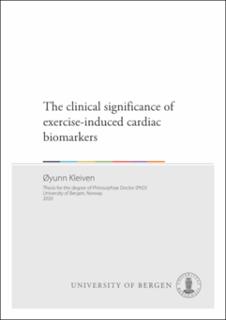The clinical significance of exercise-induced cardiac biomarkers
Doctoral thesis
Permanent lenke
https://hdl.handle.net/1956/21386Utgivelsesdato
2020-01-17Metadata
Vis full innførselSamlinger
Sammendrag
Background Physical exercise induces changes in cardiac biomarkers associated with cardiac injury and inflammation. The ability of these changes to identify subjects at risk of sport-related cardiac events is largely unknown. This project aimed to identify the physiological pattern and predictors of the exercise-induced cardiac troponin (cTn) and C-reactive protein (CRP) response to exercise. A potential pathological response to exercise was explored in a subset of subjects. Methods The exercise-induced increase in cTn and CRP were studied in two cohorts of presumably healthy recreational athletes; The North Sea Race Endurance Exercise Study (NEEDED) 2013 (n=97) and 2014 (n=1002). Both studies obtained data before and within 24 hours after a 91-kilometre cycling competition (“The North Sea Race”). Coronary computed tomography angiography was used in a subset of subjects to identify a possible association between exercise-induced cTn elevation and underlying coronary artery disease. Results In Paper 1 (n=97), we determined the magnitude and time-dependent changes in cTnI following the North Sea Race. There was a continued increase in cTnI between immediately after the race and 3 hours following the race. This finding was important for the design of the main study. Also, three of the four subjects with highest exercise-induced cTnI values had significant coronary artery pathology. In Paper 2 (n=1002), 84-92 % of subjects exceeded the 99th percentile of the cTn assay 3 hours post-race. At 24 hours post-race, 18-30 % still had cTn values above the 99th percentile. Lower race duration and higher systolic blood pressure were predictors of the exercise-induced cTn increase. In Paper 3 (n=120), subjects were assessed by coronary computed tomography angiography (CCTA). Subjects with obstructive CAD (n=9) had significantly higher cTn levels at 24 hours after the race, but not at 3 hours after the race. In paper 4 (n=97), the CRP response to exercise was determined. In this study, CRP continued to increase until 24 hours following the race. Physical fitness was found to significantly attenuate the exercise-induced CRP response. There was no association between exercise-induced levels of CRP and cTnI. Conclusion The present work identified the physiological pattern and predictors of exercise-induced cTn and CRP. More than 84 % of subjects had cTn levels above the 99th percentile cut-off. This finding supports the hypothesis that exercise-induced cTn increase is a physiological response in most subjects. Lower race duration and higher systolic blood pressure were consistent predictors of the exercise-induced cTn response. In a subset of subjects, a prolonged elevation of cTn was associated with occult obstructive CAD, suggesting a pathological pattern of cTn increase in these subjects. Lastly, physical fitness was inversely associated with the exercise-induced CRP response. No association between exercise-induced cTn- and CRP increase was identified.
Består av
Paper I: Skadberg Ø, Kleiven Ø, Bjørkavoll-Bergseth M, Melberg T, Bergseth R, Selvåg J,Auestad B, Greve OJ, Dickstein K, Aarsland T, Ørn S. (2017) Highly increased Troponin I levels following high-intensity endurance cycling may detect subclinical coronary artery disease in presumably healthy leisure sport cyclists: The North Sea Race Endurance Exercise Study (NEEDED) 2013. Eur J Prev Cardiol. 24(8):885-894. The article is not available in the thesis due to publisher restrictions. The published version is available at: https://doi.org/10.1177/2047487317693130.Paper II: Kleiven Ø, Omland T, Skadberg Ø, Melberg TH, Bjørkavoll-Bergseth MF, Auestad B, Bergseth R, Greve OJ, Aakre KM, Ørn S. (2019) Race duration and blood pressure are major predictors of exercise-induced cardiac troponin elevation. Int J Cardiol. 283:1-8. The article is available in the main thesis. The article is also available at: https://doi.org/10.1016/j.ijcard.2019.02.044.
Paper III: Kleiven Ø, Omland T, Skadberg Ø, Melberg TH, Bjørkavoll-Bergseth MF, Auestad B, Bergseth R, Greve OJ, Aakre KM, Ørn S. (2019) Occult obstructive coronary artery disease is associated with prolonged cardiac troponin elevation following strenuous exercise. Eur J Prev Cardiol. The article is not available in the thesis due to publisher restrictions. The published version is available at: https://doi.org/10.1177/2047487319852808.
Paper IV: Kleiven Ø, Bjørkavoll-Bergseth M, Melberg T, Skadberg Ø, Bergseth R, Selvåg J, Auestad B, Aukrust P, Aarsland T, Ørn S. (2018) High physical fitness is associated with reduction in basal- and exercise-induced inflammation. Scand J Med Sci Sports. 28(1):172-179. The article is available in the main thesis. The article is also available at: https://doi.org/10.1111/sms.12878.
